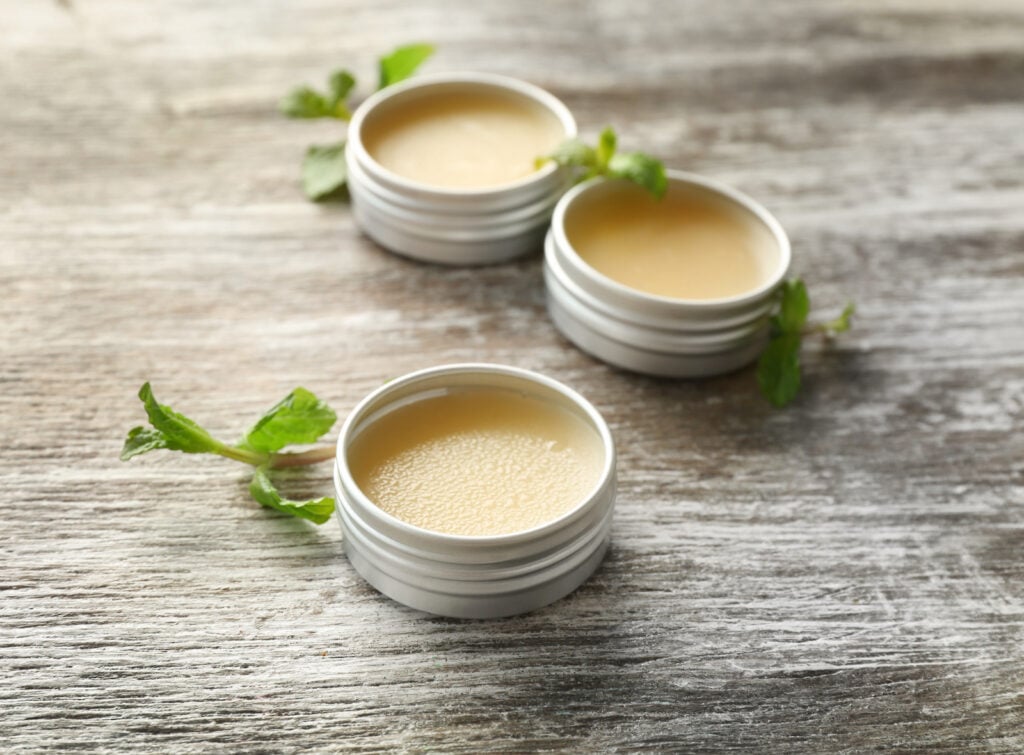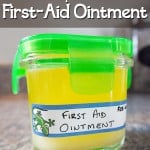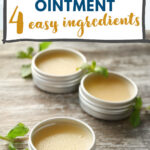Natural Homemade First-Aid Ointment
This homemade first-aid ointment is super helpful in relieving the bumps, bruises, minor burns, scrapes, and scratches that are part of life with kids.

Everyone automatically goes to a certain brand of triple antibiotic ointment for cuts, wounds, and open skin. But that brand’s base is a petroleum byproduct, and petroleum isn’t the most natural or effective way to heal a wound.
You can round out your natural first aid kit with this homemade first-aid ointment option. And you’ll feel better knowing you can trust the ingredients because you made it yourself.
Why Homemade First-Aid?
Making your own first-aid ointment comes with several benefits
- Control Over Ingredients: You know exactly what goes into your salve, avoiding unnecessary chemicals, artificial fragrances, and petroleum byproducts.
- Eco-Friendly: By reusing jars and choosing sustainably sourced ingredients, you’re reducing waste and making a positive environmental impact.
- Cost-Effective: With just a few versatile ingredients, like coconut oil and essential oils, you can create multiple batches of salve for a fraction of the cost of store-bought alternatives.
- Customizable: Adjust the recipe to suit your family’s needs by incorporating additional essential oils or ingredients for specific purposes, like calendula for extra soothing properties.
How to Make Your Own Natural First-Aid Ointment
We’ve been using this recipe for 12 years and have seen great results on everything from chapped hands to cuts and rug burns.
Ingredients
- 1/3 cup organic coconut oil
- 1 tablespoon natural beeswax pastilles
- 1/4 teaspoon Vitamin E oil
- 10 drops lavender essential oil
- 10 drops tea tree oil
If you don’t have beeswax and vitamin E on hand, you can use Waxelene or Unpetroleum Jelly. These are natural (GMO-free) alternatives to petroleum jelly generally found at your local health food or drug store.
Directions
1) Place all ingredients (except for the essential oils) in a double boiler or a mason jar in a pot of water on the stovetop.
2) Stir gently until the mixture becomes liquid and clear.
3) Remove from heat and add 10 drops of each oil (lavender & tea tree).
4) Stir and pour into a sterilized storage container.
You can use glass baby food jars for safe storage. But there’s no need to buy anything new. You probably have a glass jar from balm or moisturizer or a tin storage container that will work. Be sure to date and label your homemade first-aid ointment.
Antiseptic Properties of Essential Oils
The essential oils used in this DIY first-aid ointment are known and studied for the following antiseptic and healing / supporting properties:
Tea tree oil: antibiotic, anti-fungal, antiviral, antibacterial
Lavender: analgesic (pain relief), antibiotic, anti-fungal, antiviral, antibacterial
More Herbal DIY Recipes for Families
Making your own natural first-aid ointment is a small step with a big impact. By using carefully selected ingredients, you can ensure your family has a safe, chemical-free solution for life’s minor injuries.
Whether you’re soothing a scraped knee or easing the sting of a rug burn, this homemade salve is a testament to the healing power of nature.
Here are more family friendly holistic DIY’s:
Homemade Elderberry Syrup
Homemade Herbal Vapor Rub
How to Make a Natural First Aid Kit
DIY Iron Syrup



How long is its shelf life?
This should last for a long time. The salve itself should be fine, the essential oils may lose potency over time, but keeping it in a cabinet (away from light) or in a dark jar will help.
Could this be used for diaper rash? Thank you!
The ingredients are all CD safe, so it should be fine, but we do have a great cloth diaper safe balm recipe as well and it would be a better fit 🙂
https://www.greenchildmagazine.com/caring-diaper-rash-naturally/
This is really going to come in handy with two rough and tumble boys! I noticed a date on your jar in the picture, but there is no mention as to how long this is good for. Does it have an expiration date? Thanks for sharing!
I noted the date on the jar out of habit. I think this would last for quite a long time. I have jars of store bought salve that are a couple of years old but still work great, and I would expect the same of this so long as it’s kept out of direct sunlight and extreme temps.
ThAnk you foe the recipe for cut and bruise cream. I love getting cost saver ideas, especially when they are better for you.
Thank you for the recipe for cut and scratch cream. Love to get this replacement ideas.
Hi! In regards to the recipe for the homemade first-aid ointment using Waxelene; I read the reviews on Amazon and it looks like Waxelene is an ointment all on its own so is there any benefit to purchasing the other ingredients/oils when Waxelene could be used by itself? I’ve never experimented with any homemade items like this before so it’s all new to me! Thanks for any input!
I have Waxelene and it’s fine on its own, but the essential oils and coconut oil contain additional properties that aid healing and inflammation.
I grew up with a product called Hearn’s Salve in Carrollton, GA. It worked wonders. My mom even sent a tin with me to summer camp. It was patented in the 1920’s.
Marian-would appreciate information about Hearns salve.I have used since childhood, understand that someone in my family (Tyos?) made it in Carrollton,Ga. I still have a little bit of a tin left, and would like more. Regards, Clyde Dekle, St Simons Island, Ga.